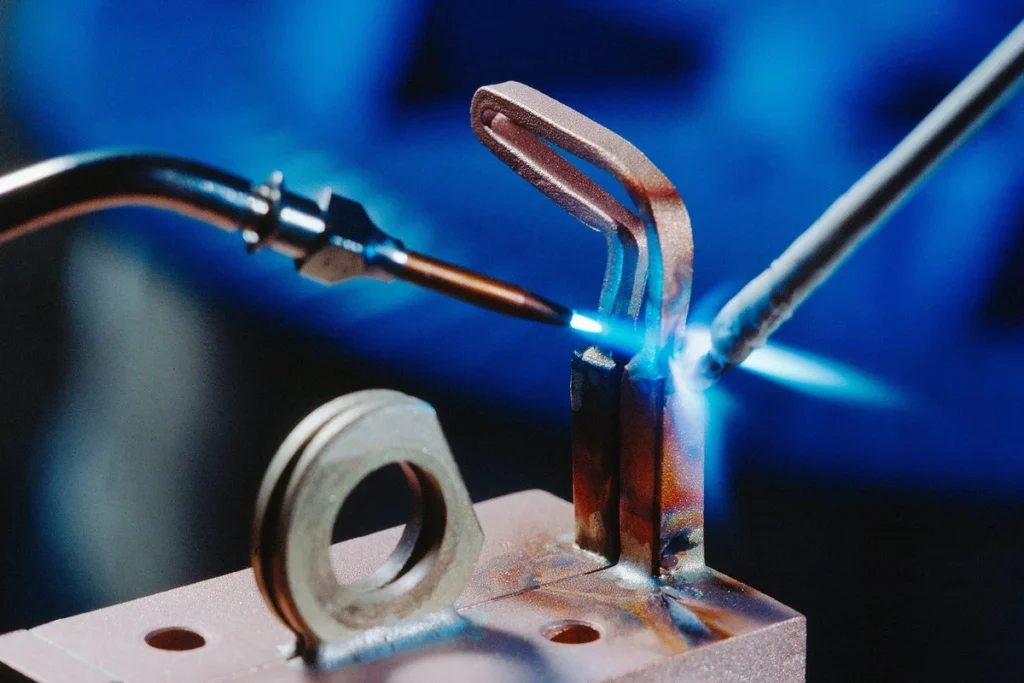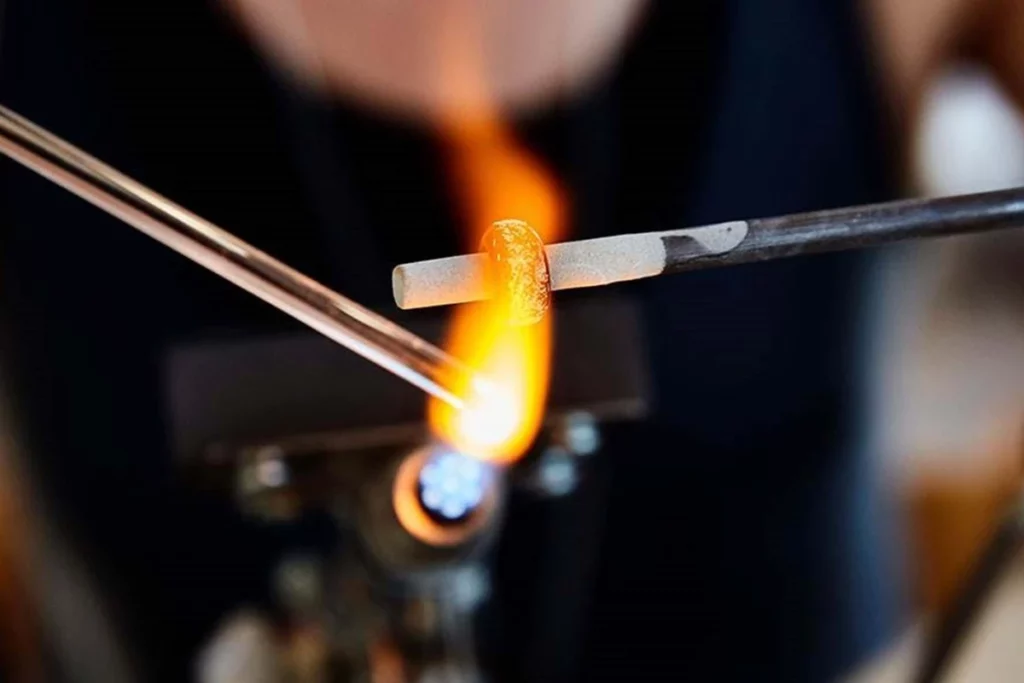You’ve probably heard the term “brazing,” but what exactly does it mean, how do you use it in your everyday life, and what metals can be brazed?

In this article, we will discuss the various types of materials that are suitable for brazing. We’ll also talk about some safety considerations when working with different metals—as well as why brazing may be preferred over other methods like welding for certain applications.
Let’s start by identifying some metals that can be brazed and a few factors to consider.
What Metals Can Be Brazed?
The most common metals used in brazing today include stainless steel, nickel alloy, and aluminum. Nevertheless, in order to produce a strong bond, each metal will require a different process of application.
With that being said, here is a list of metals that are often brazed:
Cobalt alloys are particularly useful for aerospace engineering and medical devices.
Some Points to Note
Metals with low melting points, such as magnesium, are prone to cracking under extreme thermal stress. Gold and silver can react with oxygen in the air to produce toxic fumes. Brazing these two metals involves tremendous caution and accuracy. As a result, soldering is preferred over brazing.
Additionally, aluminum cannot take the heat needed for proper brazing. You must either work quickly after pouring the aluminum into the mold or preheat the part to soften the material prior to placing it inside. Either way, it takes several hours to cool off completely.
Key Features of Brazing
If you have ever been on an airplane or driven through traffic while listening to music at high volume, then you have experienced the sound of something vibrating against another thing. The noise comes from air particles being forced into tiny crevices between one object and the next.
These spaces cause friction, which generates heat. When enough heat builds up, the material begins to melt, flow, and fuse together. This process is called fusion bonding (or sometimes diffusion bonding).
1. No Pressure Involved in Brazing
Fusion welding occurs because of pressure and temperature differences between both objects. In contrast, during brazing there is no pressure involved, so only surface tension causes the bond.
2. Brazing Is Relatively Inexpensive
Brazing has become more popular lately due to its lower cost than traditional welding techniques.
This method was used throughout many industries before modern technology made better ways to join parts. For example, if you were making a ship out of wood back in the day, you would need to make sure all the joints could withstand rough weather conditions.
If they didn’t, water might seep in where the seams met, causing rot. To prevent this, builders would often use copper nails instead of iron nails to hold wooden planks together. A similar technique was later developed to create railroad tracks.
Using rails embedded with spikes, cars moving along the track wouldn’t rub against each other, creating wear and tear. Instead, the rails would simply touch across the gaps without any contact required. Today, these same principles are still true even though our tools are much improved.
Modern machines such as lasers, plasma cutters, and grinders can perform tasks faster and cheaper than human hands. They don’t get tired, hurt, or develop carpal tunnel syndrome! But their biggest advantage is precision since they can cut right down to very small dimensions.
3. Brazing Doesn’t Require as Hot a Flame as Welding
As mentioned earlier, fusion welding requires intense temperatures and/or pressures. Welding works differently, and although it too involves heating the joint to produce a chemical reaction, it usually doesn’t require nearly as hot a flame. And brazing doesn’t require as hot a flame as welding.
4. Flux Isn’t Necessary for Brazing
Another difference is that welds typically involve additional elements like fluxes that clean the surfaces and help form a strong bond. Flux isn’t necessary for brazing and is, therefore, less hazardous. However, if you decide to use flux, please consult your local OSHA regulations first.
Factors to Consider When Choosing Metals to Be Brazed
Factors besides strength play into choosing whether to go with brazing or welding. Depending upon the application, environmental concerns, ease of maintenance, and aesthetics can determine which type of equipment is best suited to complete a project. Let’s look at some examples.
While it may seem counterintuitive, aluminum is more susceptible to oxidation than titanium. As such, titanium needs special treatment to avoid discoloration and pitting.
On the other hand, pure aluminum tends to darken rapidly once exposed to air. Because of this, aluminum is commonly cast within molds so it hardens gradually rather than instantly. Since it can crack easily, aluminum components are designed to support internal stresses and minimize fatigue cracks. It’s important to note that if you’re going to put a piece of aluminum outside, you’ll want to coat it with paint or clear lacquer to protect it.
Steel has long been known for its durability and availability. Unfortunately, it’s highly vulnerable to rust. Although it holds up well outdoors, steel products tend to corrode quickly indoors. Stainless steel is especially good at resisting rust and has gained popularity recently thanks to its ability to blend seamlessly with other colors.
While stainless steel looks great and lasts longer, it’s expensive and difficult to manufacture. That’s why it’s mostly seen in luxury items. Some people believe that stainless steel appliances are unhealthy for humans, but recent studies show otherwise.
The Benefits of Laser Brazing Mixed Metals
Laser brazing offers a lot of advantages when compared to conventional brazing processes.
1. Precision
Laser beams allow precise control over the size, shape, and location of joints. This makes it easier to achieve uniform thicknesses and tight tolerances.
2. Consistent Power and Energy Output
Also, unlike gas tungsten arc lamps, lasers emit light continuously without having to pause every few seconds to adjust the intensity. Lasers provide consistent power and keep the energy output constant. This allows workers to perform repetitive operations safely and efficiently.
3. Perform Multiple Functions Simultaneously
Lastly, lasers are capable of performing multiple functions simultaneously. For instance, one machine can cut a big blank sheet of metal, turn around half a million pieces of flat stock, and trim edges all in just five minutes.
The Disadvantages of Laser Brazing
Despite the benefits associated with laser brazing, it’s not perfect. One potential problem relates to the fact that laser beam sources generate electromagnetic radiation. Electromagnetic waves carry electrical currents that induce eddy current losses and magnetic fields. Eddy currents dissipate heat and reduce efficiency.
This effect limits the maximum operating speed of the laser. Additionally, photons emitted from the laser source interact with electrons in the target material, producing secondary x-rays. X-rays pose health risks and damage sensitive electronic systems. Finally, debris generated by the action can contaminate the finished product quality.
What Metals Shouldn’t Be Brazed?
Some metals shouldn’t be combined via brazing. Here are three notable ones.
1. Pure Alumina Powder
Aluminum oxide is formed naturally in nature. Its crystalline structure provides excellent protection from moisture and corrosive chemicals. Unfortunately, the substance becomes brittle when heated above 2000°F (1100°C).
Pure alumina powder is extremely abrasive, so handling it requires wearing thick gloves and protective eyewear. Alumina can also scratch tool bits and cutters. Most manufacturers who use brazing to attach ceramic bodies to machined metallic parts coat them with a thin film of liquid brazing compound.
Once coated, however, the outer layer melts away, exposing the underlying basecoat. This leaves behind a shiny bead that weakens the overall structural integrity of the component.
2. Hafnium Powders
Hafnium powders come in shades ranging from bright yellow to silvery white. They’re widely used in the industry for electronics manufacturing. Uncoated hafnium beads absorb moisture and expand significantly when wet. Unlike natural alumina, hafnium powders aren’t crystalline structures.
Rather, they consist of irregularly shaped particles that range in size from 0.5 microns to 1 millimeter. Their large specific surface area leads to rapid hydration. Hafnium oxides are also hygroscopic, meaning they attract and retain water vapor.
As a result, the porous metal swells to twice its original volume. HfO2 reacts violently with acids and alkalis. When exposed to moisture, it absorbs water molecules until saturation.
Then excess water dissolves ions, leaving behind a residue that prevents further reactions. Overheating hafnium past 1100 degrees Celsius (2000°F) results in Sinterization. Sintered hafnium loses malleability and ductility, turning brittle and inflexible.
3. Titanium
Titanium contains trace amounts of nitrogen and carbon. Nitrogen atoms chemically combine with hydrogen present in the surrounding atmosphere to form ammonia gas. Carbon combines directly with oxygen to form CO2.
Both gases contribute to exothermic chemical reactions, leading to increased temperatures. Excessive heat breaks down Ti-6Al-4V into alpha phase titania (TiO2), which reduces performance.
Ammonia and CO2 released by reacting nitrogen and carbon can also poison catalytic agents used in fuel cells. Furthermore, titanium is soft, pliable, and inert. It lacks reactive properties and doesn’t dissolve readily. All of these characteristics limit its usefulness as a brazing medium.
Why Welding May Be Preferable to Brazing
We’ve now learned that brazing is generally preferable whenever possible. However, there are times when welding is unavoidable. Consider the following scenarios:
However, when it comes to combining metals with different metallurgy, brazing is a better option than welding. In mixed metal applications, laser brazing offers a number of advantages that lead to increased efficiency and cheaper production costs.
Darell is a Certified Welding Engineer (CWEng) with over 23 years of expertise in TIG, MIG, MAG, dual flux, and stick welding. He is a senior welding engineer who has a desire to share his experience. Visit unwelded.com and join Darell as well as other welding enthusiasts in obtaining fabrication knowledge, amazing welding gadgets, and useful welding insights.
